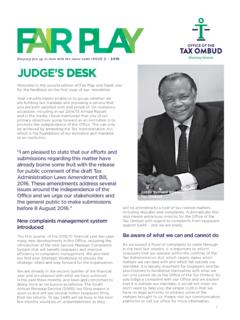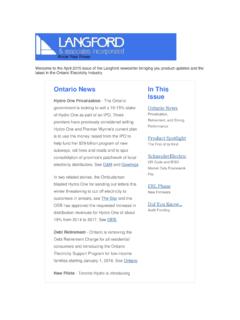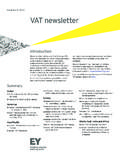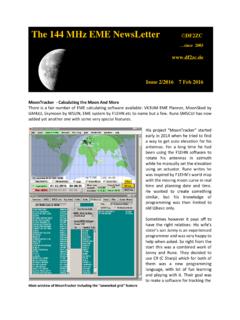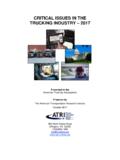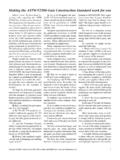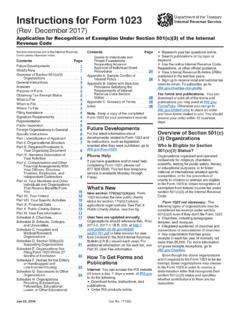Transcription of EPA Reportable Quantities (RQ) and Misnomers1
1 HazMattersPhiladelphia Chapter - ACHMM NewsletterVolume 2 issue 6 September 2002 Officers:Vice President Joann CortesePresident Dave MatthewsSecretary Tanya WarsheskiTreasurer Bob MayImmediate Past President Donna SwitzerPage 1 EPA Reportable Quantities (RQ) and Misnomers1 When profiling and shipping hazardous waste versus a raw chemical product, I ve run into thedebate over the application of the RQ designation. The RQ, Reportable quantity, designation is aterm both EPA and DOT use to describe a material that is or contains a hazardous , when to use it on shipping documents versus packages is where confusion article will outline the basic application of an RQ designation on packages and and DOT have the same definition for a hazardous substance. Hazardous substances arematerials that can be extremely harmful to the environment when released. EPA comprised a listof hazardous substances that can be found under 40 CFR DOT adopted the same list andincorporated it under 49 CFR Appendix A, Table 1 and Table 2.
2 The distinctionbetween EPA s and DOT s designation is that a material is only considered to be a hazardoussubstance under DOT if it is listed under 49 CFR Appendix A and is transported in apackage that contains a Reportable quantity of that substance. Under EPA, the material has to belisted under 40 CFR the determination has been made as to whether the material is a hazardous substance , thenext designation to determine is whether the package contains the Reportable quantity of eachhazardous substance. A Reportable quantity (RQ) is the amount of hazardous substance thathas to be released into the environment before the EPA requires notification of the release to theNational Response Center. These numerical designations are listed under 49 CFR A, Table 1 and Table 2. The lists contain chemical names and EPA waste codes. Ifthe material is below the concentration Quantities shown, the RQ designation does not apply. Ifyou meet or exceed the concentration Quantities shown, the RQ designation is required.
3 If youhave a mixture, you can use the chart under 49 CFR that converts RQ pounds intoconcentration by weight per percent or parts per million (ppm) to determine the RQ for a specificconstituent in the mixture. For example, any hazardous substance with an RQ value of 10pounds ( kilograms) would have a percent or 200 ppm concentration by weight. WhenHazMattersPhiladelphia Chapter - ACHMM NewsletterVolume 2 issue 6 September 2002 Officers:Vice President Joann CortesePresident Dave MatthewsSecretary Tanya WarsheskiTreasurer Bob MayImmediate Past President Donna SwitzerPage 2selecting an RQ designation for characteristic waste (ie D001, F002), if the amount of eachhazardous substance is known in each waste container, the characteristic RQ value need not beused. The RQ value for each hazardous substance would be used. If the material has multipleRQ values, the lowest RQ value is to be the RQ designation is required, it is used in conjunction with the DOT hazardous materialsshipping description.
4 The letters RQ need to be entered before or after the basic shippingdescription. If more than one RQ exists for the material, each hazardous substance containing anRQ must be listed. For example, Environmentally hazardous substance solid, , 9, UN3077,PG III, RQ (Thiuram) or RQ, Allyl alcohol, , UN1098, PG you need more information on this topic, please access EPA s or DOT s T. Warsheski, CHMM; Hazardous Materials SpecialistRSPA Proposes Security Requirements2 Ever since September 11, 2001, the United States has been asking everyone to focus on securityissues. In response to this request, many agencies have been proactive in their efforts. TheAmerican Chemistry Council published two Security Guidance Documents. Once to assist theChemical Manufacturing Industry and one for Chemical Carriers. The biggest news breakingeffort has come from the Research and Special Programs Administration (RSPA). RSPA hasbeen actively pursuing changes in the DOT regulations to enhance the security of hazardousmaterials transported in commerce.
5 The proposals to current regulation include: a requirementfor motor carriers to maintain a copy of their current registration certificate on each motorvehicle; require shipping papers to include the name and address of the consignor and consigneeand the shipper s DOT Hazmat Registration number, if applicable; require shippers and carriersof certain highly hazardous materials to develop and implement security plans; and requirehazardous materials shippers and carriers to assure that their employee training includes asecurity component where the employee is trained to recognize and respond to security threats. 2 T. Warsheski, CHMM, Hazardous Materials Specialist; DGI News, issue No. 24 Summer 2002 HazMattersPhiladelphia Chapter - ACHMM NewsletterVolume 2 issue 6 September 2002 Officers:Vice President Joann CortesePresident Dave MatthewsSecretary Tanya WarsheskiTreasurer Bob MayImmediate Past President Donna SwitzerPage 3 Federal Government to Pay for Cleanup3In an article published by Waste News, a federal appeals court has ruled that the federalgovernment must pay for the cleanup of a Superfund site in Torrance, California, thatmanufactured synthetic rubber during World War the court s opinion, the judge stated that this was a shocking case.
6 The government is tryingto take money from firms it conscripted for a critical part of a great war effort. The governmentargued that Dow Chemical Co., which operated the plant on behalf of the government, cannot bemade to share in the cleanup federal government oversaw the construction of a synthetic rubber plant and hired Dow tooperate because of its expertise in the area. The government owned the property, plant, rubberand waste because Dow was bound by its contract to carry out the instructions of the federalgovernment, including instructions about handling toxic waste. Aluminum chloride sludge andsulfur were kept in evaporation ponds at the government argued that Dow should share in the cleanup costs because the company hadmanagement expertise in handling the waste and because it dug the pits, transported the waste tothe pits and maintained security at the pits. The government also argued that Dow was paid forits services and gained valuable court pointed out in its ruling that Dow accepted compensation far below market rates andthat the government knew all along that soil and water were being polluted.
7 The governmentdecided at the time that polluting the land and water this way was preferable to divertingresources from the war effort to do anything about it , the court stated in its written opinion. Now the government wants its servants to pay for what it told them to do and promises themthey could do with no fear of liability: 3 Bruce Geiselman, to pay for Calif. Cleanup, Waste News , August 19, 2002 HazMattersPhiladelphia Chapter - ACHMM NewsletterVolume 2 issue 6 September 2002 Officers:Vice President Joann CortesePresident Dave MatthewsSecretary Tanya WarsheskiTreasurer Bob MayImmediate Past President Donna SwitzerPage 4 The court said that according to the governments logic, it could ask American soldiers whobattled the Japanese in Alaska s Aleutian Islands to share in the cost of cleaning up the lead fromtheir GENERAL MEETING OF 2002 The Fourth Philadelphia Chapter Meeting will be on September 18th, 2002.
8 The meetingwill be held at the D Ignazio s Towne House Restaurant in Media, PA. The agenda for themeeting is a guest speaker who will be giving a technical presentation entitled Implementing anAir Resources Management System; Lessons Learned . The dinner will start at 6pm and the costis $ per person. The dinner choices are Capon & rice or Veal you plan on attending, please respond with your dinner choice no later than September 12,2002. You can e-mail your attendance to or by calling TO TOWN HOUSE (610-xxx-xxxx):Take Route 476 (Blue Route) to Exit 3 (Media/Swathmore). If traveling South on Rt. 476, make a right ontoBaltimore Pike. If traveling north on Rt. 476, make a left onto Baltimore Pike. The restaurant is miles from on the Dates for 2002:March 20 May 16 September 18 November 12 INTERNET : Environmental Protection Agency : Code of Federal : NJ : PA : MSDS archive (free) : DOT Hazardous : Current issues and regulations regarding solid waste with links to numerousother waste and environmental Chapter - ACHMM NewsletterVolume 2 issue 6 September 2002 Officers:Vice President Joann CortesePresident Dave MatthewsSecretary Tanya WarsheskiTreasurer Bob MayImmediate Past President Donna SwitzerPage 52001 IATA Regulatory Changes with 2002 Updates5 The 42nd edition of the IATA Dangerous Goods Regulations was made effective January 1,2001.
9 Here are the major changes: Extensive changes were made to radioactive (class 7) requirements. These will beeffective in July to coordinate the same effective date for all modes of transport New exclusions were made for some explosives (class 1) As of June 1,2001 Federal Express will not accept dangerous goods declarations unlessthey are computer generated or typewritten. See FX-12 Delta Airlines is requiring all liquid dangerous goods to be packed in combinationpackaging with sufficient absorbent to absorb the entire contents of the innerpackaging(s). See DL 14 Numerous changes were made to Section List of Dangerous Goods. Please watcheffective dates of all changed items. Packing Instructions Section 5 contains many changes with different effective dates. Numbers may be shown on subsidiary hazard class labels. effective July 1, 2001 Added the requirement that the basic description on the Dangerous Goods declarationmay not have any additional information interspersed.
10 That description is ProperShipping Name, Hazard Class, Identification Number, Packing Group, if applicable andsubsidiary riskSee "Samples for further testing" shipment requirements now mirror the requirements of lastyear's US state variation 14 The newest changes to the regulations are minor. To view the complete list and the latestcorrections and additions to the 2001-2002 ICAO Technical Instructions issued on 01/15/02,access 5
